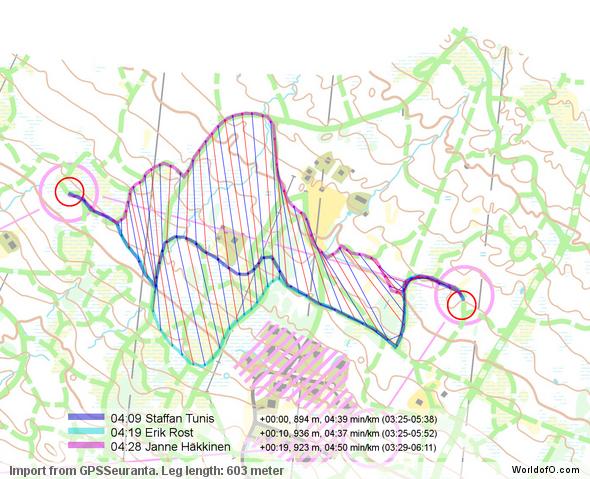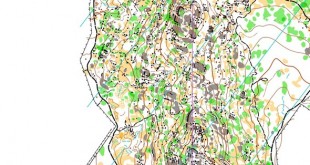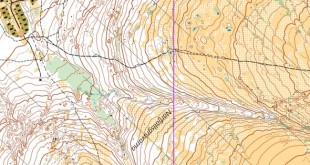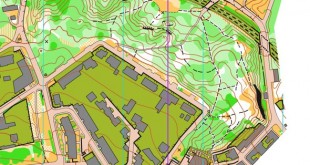The live headcam footage from the course was a first within orienteering – and made it possible to feel the speed of the athletes – and see some of the challenges the athletes met on the course. Even without GPS Tracking, the Mixed relay at Ski WOC yesterday showed good TV potential! That said, it was far from a perfect web-TV broadcast, but I saw so much potential that I had to write a short post about it after my negative article about the EOC Ski-o mass start earlier this winter!
Take a look at this video from around 37 minutes to see an example:
The good:
- Live headcam footage is one of the best ways to show what the sport is really about. Great!
- The mixed relay format chosen in ski-orienteering with two athletes, each skiing three legs of 10 minutes, worked very well. The race was tight, with several teams changing in the lead throughout the relay. I think this might work even better than the 2 men + 2 women mixed relay format suggested for WOC in foot orienteering (but maybe only if it is run in the forest instead of in a city – too early to say without testing different concepts, which should of course be done before a decision for the future WOC format is done…).
The bad:
- No GPS-tracking. The reason for this was that the organizers could (1) only use it on the last leg due to the usual issues with GPS-tracking on relays and (2) they could only use it on a small part of the terrain due to reuse of parts of the terrain on the races this weekend. Thus they decided to skip it completely.
- WebTV quality was not the best – and it was also lagging almost 10 minutes(!) towards the end of the race. The headcam quality was difficult to judge, but it looked like there is a way to go there as well.
Further improving the good parts – and including GPS-tracking on all legs, this could really have potential as a TV sport! In an article at ski-o.com yesterday it was written that the work around this mixed relay was partly driven by discussions about TV broadcasts at Eurosport from this Ski-o WOC. And actually I believe that this can be developed into something which is interesting for the sports channels – the key is in bringing the action, the excitement and both how and when the decisions happen out to the viewers. And I think the track there goes through further developing GPS-tracking and headcam footage – both for ski-orienteering and foot-orienteering. Developing the technical bit is more important than developing new concepts in my opinion – keep it simple, and improve the visualization!
More from Ski WOC 2011
Some links from the Ski WOC 2011:
- Ski WOC 2011 webpage. From the organizers webpage:
– Mixed relay has come to stay!, says today’s winner Andrej Grigorjev. In the Russian gold team was also Polina Malchikova, who won the middle distance in Tänndalen on Tuesday. But none of the skiers in the Russian duo was in the lead until the last distance, where Malchikova finished strong and was able to take the gold medal. The mixed relay gave both the spectators and the athletes an exciting race where four teams long was in the running for the medals. Finland’s experienced duo Matti Kerkinarkaus, WC-debutant 1998, and Liisa Antila finished in third place – beaten by Russia with 45,5 seconds. Norway came in fourth place (Hans Jörgen Kvåle and Stine Olsen Kirkevik). They were 1.04,9 after Russia. - Report from the sprint relay from IOF A real cliffhanger thriller took place today, when a mixed sprint relay was organized for the first time at the World Ski Orienteering Championships in Tänndalen Sweden.
Interviews/previews from earlier on in the championships
Ski WOC 2011: Middle winners from SkiOTour Club on Vimeo.
Ski WOC 2011: Sprint winners from SkiOTour Club on Vimeo.
Program
- Tuesday March 22nd. Sprint, 10:00 CET
- Wednesday March 23rd. Middle, 10:00 CET
- Thursday March 24th. Mixed relay 15:00 CET (2 skiers on each team, 3 times per skier)
- Saturday March 26th. Long 10:00 CET
- Sunday Match 27th. Relay 10:00 CET
 World of O News
World of O News







Situations changing constantly was most due to forkings, which made actually following the race very difficult.
Special effort should be made to have forkings equally long.
Thanks for info. Still haven’t seen the map, so I didn’t know how the forking was done. But absolutely agree – forking should be as equal as possible.
Good article. I´d like the idea too. I think IF Hagen tested to have a following camera during youth-10Mila (in august) last year. But i dont know the result..
The headcam transmitting equipment that is used during this championship is the same that was used during U10 and also by swedish TV during Vasaloppet, but the technique is still very new and will develop a lot in the next years/ Per Frost, Ski-Woc Broadcast manager
The athletes might not like it, but very short interviews between legs would be something to test. I think it would make the event more interesting for a TV-spectator.
The live headcam was great.
We are pleased with all your comments and feedback to improve both the format and the production.
Given the circumstances and miniscule (no)budget Carl Magnusson, Per Frost, Henning Spjelkevik et al. did a fantastic job.
The forkings were very close – all of them within 50 meters in lenght and 40 seconds in time. It is rather difficult for the course planners to make it even better, but we’ll definitely review the feedback and format.
I may be biased, but I think that the entire forking issue is more a problem to die-hard orienteers than for the general public. Less experienced spectators preferred the drama. What if in all relays we had always forking into the last control, and all the teams and competitors knew this and that the only tactic was to go flat out on every leg…
Please share your views.
Thanks again for nice entertainment! I’ve sent some further comments to Henning – we’ll see if I can see any of it tomorrow:)
Regarding the forkings, I’ve got to see them before I can comment in detail. However, in general I think the most important thing is that the viewer knows what the actual standing is, so that you can see how and why the decisions are made. If the forkings are very uneven, you can’t really know. 40 seconds might actually be too much in such a tight relay. That means that Russia might have been in the “virtual” lead out on the last leg, even if they actually were 40 seconds behind (I don’t recall if it was 40 seconds, but you get the idea). As it was now, I was sure that Norway/Sweden must have done some big mistake (which they again might have for what I know).
Anyway – it was exciting to watch – and I’m looking forward to further development of the concept!